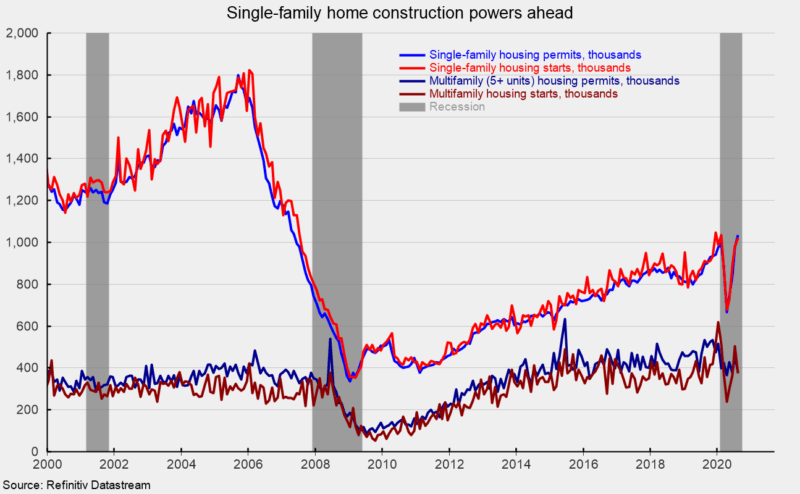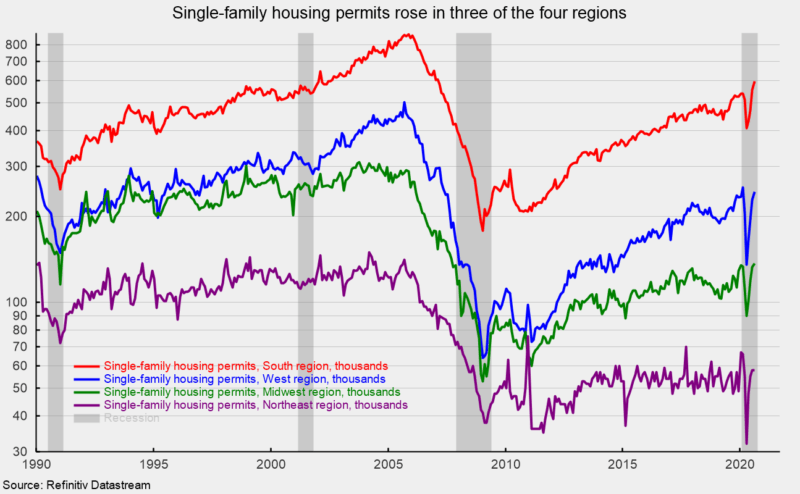Single-Family Housing Permits Hit a Multi-Year High
Housing activity – starts and permits – posted mixed results in August as declines in the multifamily segment offset gains in the single-family segment. Within the single-family area, there were gains in starts and permits with strength spread across most regions.
Total housing starts fell to a 1.416 million annual rate from a 1.492 million pace in July, a 5.1 percent decrease. The August decline followed three consecutive gains from an April low.
The dominant single-family segment, which accounts for about 70 percent of new home construction, rose 4.1 percent for the month to a rate of 1.021 million (see first chart). Starts of multifamily structures with five or more units plunged 25.4 percent to 375,000 (see first chart). From a year ago, total starts are up 2.8 percent with single-family starts up 12.1 percent and multifamily starts down 16.9 percent.
Among the regions in the report, total starts rose in two regions and fell in two regions. The Northeast led the decliners with a 33.1 percent drop while the South, the largest region by volume, declined 17.7 percent. The Midwest surged 28.4 percent and the West gained 19.5 percent for the month. For the single-family segment, the Northeast again led the decliners with a 21.9 percent drop while the South fell 3.8 percent. The Midwest gained 20.0 percent and the West jumped 23.4 percent for the month
For housing permits, total permits fell 0.9 percent to 1.47 million from 1.48 million in July. Total permits are 0.1 percent below the August 2019 level. Single-family permits were up 6.0 percent at 1.036 million, the highest rate since May 2007 while permits for two- to four-family units gained 17.8 percent and permits for five or more units decreased 17.4 percent to 381,000 (see first chart).
Permits for single-family structures are up 15.6 percent from a year ago while permits for two- to four-family structures are up 26.2 percent and permits for structures with five or more units are down 28.5 percent over the past year.
Single-family permits rose in three of the four regions in the report, with the South up 7.0 percent (the highest since February 2007), the West posting a 7.0 percent rise, the Midwest also gaining 7.0 percent but the Northeast unchanged (see second chart). From a year ago, the South is up 16.6 percent, the West is 13.4 percent higher, the Midwest gained 22.3 percent and the Northeast rose 1.8 percent.
Home construction activity has recovered sharply since the April low as lockdown restrictions that impacted both construction workers and potential customers were eased. Mortgage rates are near all-time lows, providing support for the recovery though lending standards have tightened amid the policy-induced economic malaise.
Housing is one of the areas that may be experiencing structural change. If it is believed that higher density living represents a higher risk in future pandemics, then there may be sustained added demand for less dense suburban and rural housing, especially single-family dwellings. This trend could be boosted if businesses implement permanent work from home policies, to make employees happy but also to cut down on high-cost commercial real estate, especially in high-density, high-cost cities.







